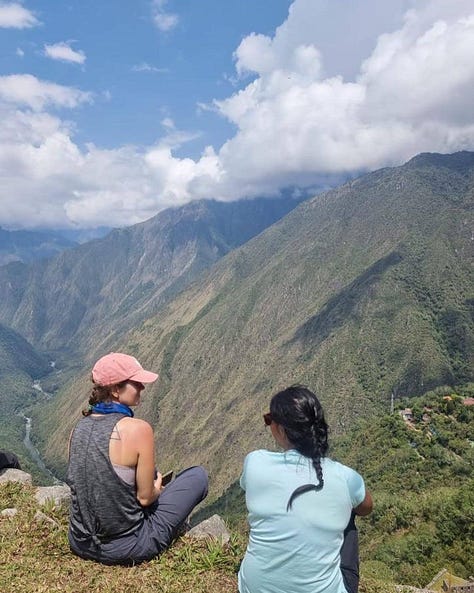
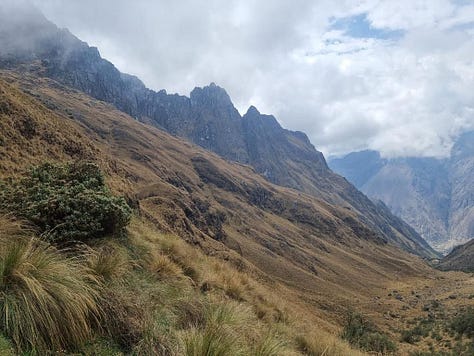
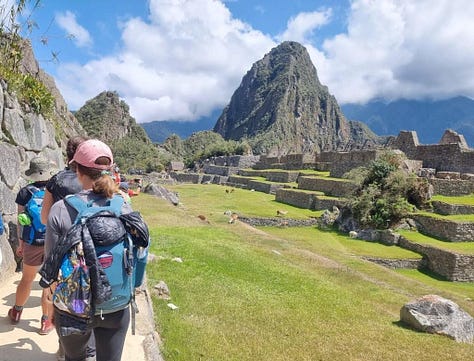
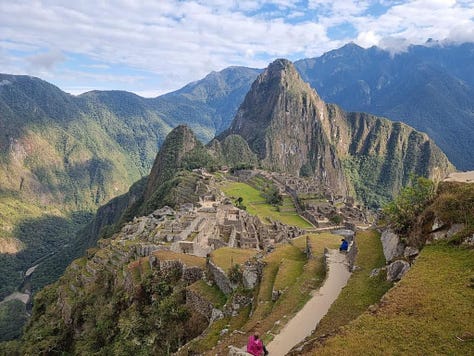
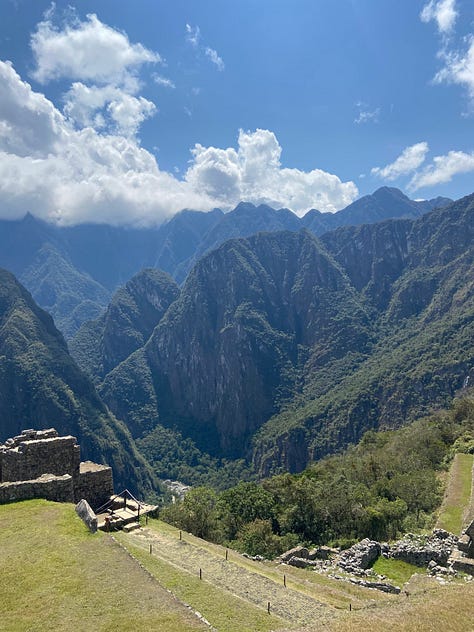
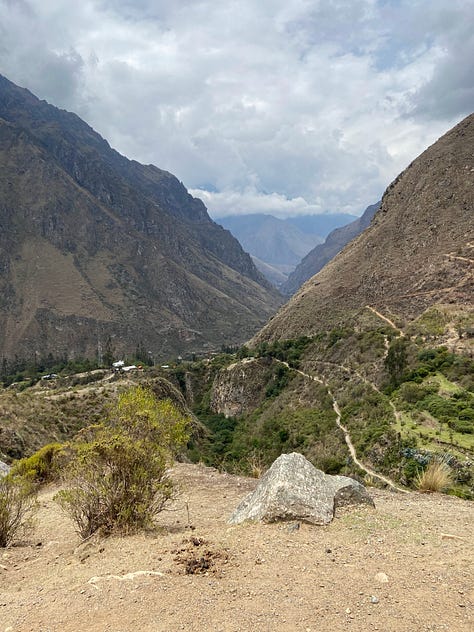


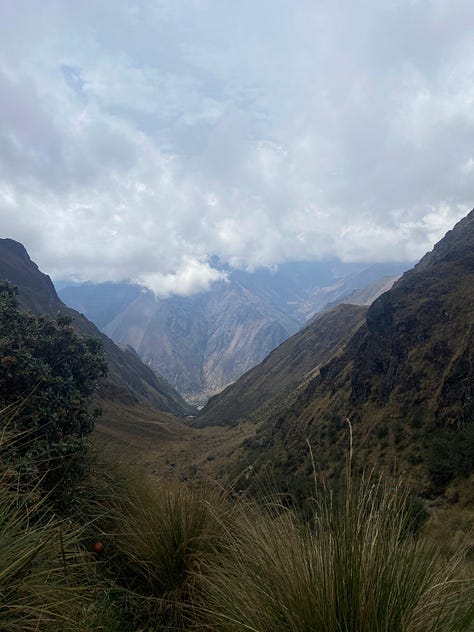
Welcome, reader/subscriber/new friend, to the first edition of my newsletter. I am excited to have this outlet to share things in the tourism industry and research or article that I come across and want to share with others.
I want to start by saying that after nearly two years of not really going anywhere, the end of 2022 was a busy travel season for me. I went to Peru in October, the Galapagos (Ecuador) in November, and visited the US in December for Christmas to see my family. It kind of felt like catching up on 2 years of travel. It was mostly smooth sailing but there were some hiccups like major delays and one caused by an unruly passenger. However, I am grateful for the adventures I had in the last quarter of 2022 and all of the family and friends I got to see and hug for the first time in a long time.
I’m going to be linking and discussing travel/tourism industry news in this twice-monthly newsletter that will be published on the 15th and the 30th. As time goes on, perhaps I’ll be offering a third publication during the month that goes more in-depth and is an inexpensive paid option or offering one free and one paid. I’m going to let it evolve naturally.
Let’s dive in…
Airlines
Bag checking fiascos
One thing that I think a few airlines are doing really well is bag tracking. Both American Airlines and United Airlines are now allowing passengers who download their apps to track their bags during their travels. I find this extremely comforting since, during the summer, many of the news stories were about lost and delayed luggage. I know that Apple airtags were and are popular right now, but I find those problematic. Why? Because the passenger can track their bag. and be furious about it when it is lost or misplaced - I’ve been on the receiving end of this frustration in my current role and no, I have nothing to do with a lost bag. Just as the airtag has nothing to do with the airline so you just have an angry traveler who is sure of where their bag is but can’t really do anything about it. I am sure airtags are mostly reliable but they can also fail!
Some friends of mine who are a traveling circus performance group had a month-long performance at the Edinburgh Fringe Festival last August and had to check large and expensive equipment for their performances. This equipment was essential to their performance - no equipment, no show! All of these pieces of luggage had airtags in them but did not make it on the flights. It was incredibly infuriating for the group to see they’d been left behind at O’Hare in Chicago and required a lot of work and a visit to O’Hare from one of the circus students. The airtags were helpful but a tracking system like American Airlines or United Airlines uses would have been more helpful in locating and sending them over in a swifter and less complicated manner.
I find the airline’s bag-tracking process to be a much better solution and it is only a matter of time before the rest of the airlines follow suit. It is a good development that I hope is adopted industry-wide. It might slow down the loading and unloading process a little bit since each bag’s tag and barcode has to be scanned with a handheld scanner by a real person - I’ve watched the process from my airplane seat - but it is more accurate than the Apple Airtag.
American Airlines actually implemented its tracking system in 2017! See this article about it, but the pandemic surely slowed down the travel industry and surely that feature was not as pressing as staying afloat. I am sure that others will adopt it soon. Thoughts? Do you use Apple airtags? Do you find them useful? Do you think other companies will develop a similar product or do you find the airline’s luggage tracking within the app more useful?
Other airline perks
In that same vein, Delta is rolling out free wifi on its flights to all SkyMiles members. Not a member of their loyalty program yet? You can sign up now and still take advantage because there is no minimum mileage requirement.
Other US domestic carriers have recently tested similar programs but according to Afar, currently, only JetBlue offers this same perk. As noted earlier in this newsletter, it is important for these airlines to stay competitive by jumping on board with the same offerings or trends. So it is possible that this could become standard among US domestic carriers and beyond.
Does this entice you to fly with Delta or are you the type who enjoys being disconnected on flights? I do like the uninterrupted reading time that flights provide but it would be nice to have access to wifi for free since the current cost of wifi on a flight is ridiculously expensive. Free wifi access should be part of the flight. I still don’t want people talking on their phones on the flight though. Airplanes will hopefully still remain phone-call-free spaces. :)
More airline shenanigans
I can across this article about couples who book aisle and window seats on commercial flights hoping that the middle seat will stay empty so they can have the row to themselves. There are some strong opinions in that article. I’m not sure how I feel about it. I do think that if some poor soul ends up in the middle seat and the couple talks and gestures around and over the middle seat person, that is rude and annoying and one of them should probably switch seats with the middle seat. Put yourself in that middle-seat situation, what do you think? I’d be annoyed if a couple was talking and gesturing over me when they could just switch and sit next to each other. If that tactic works, cool, good for them. If not, switch with the middle seat person and save them some misery.
Tourism and civil unrest
Travel can be unpredictable and messy. Peru is a beautiful country rich in culture, environment, landscapes, language, cuisine, you name it, the South American country has so much to see and learn about.
Various reasons and tourism niches that draw tourists to Peru:
An interest in trekking to hike the Inca Trail or Salkantay trail that both terminate at Machu Picchu
To see the archaeological sites of the Incan Empire like Machu Picchu and get there by train
The country’s biodiversity and eco-tourism - as mentioned, there is a lot packed into the country’s size from coastline to mountains to Amazon rainforest with cities in between.
Peru also appeals to tourists who seek out mystical tourism experiences. What the heck is that? Here’s a link to a paper that explains more but basically, Machu Picchu is a highly spiritual cultural site from history and there are people who seek to visit the site and other Inca sites because they are energy centers. Peru isn’t the only place in the world that experience spiritual tourism. Rapa Nui (Easter Island), Sedona, and even Stonehenge in England. Peru’s national travel agency leaned into this, as you’ll read in that paper if you choose to do so, by advertising Peru’s magic and mysticism. Even where I work, a colleague mentioned that you are called to hike the Inca Trail by Pachamama, or Mother Earth.
Since December, there have been protests in Peru that have put residents and tourists in danger. It was and still is scary for Peruvians as well as for any tourists who got stuck in various parts of the country. However, I just had an acquaintance return from Peru completely unscathed - some of her excursions were canceled. And, I do know that the Inca Trail guide from my October trip was stuck in Machu Picchu for a while. The situation is changing but there is not a resolution yet. I could explain it but I would not do as good of a job as some of the resources I’m linking at the end of this as further reading to understand what is going on in Peru. The Daily episode and a Reuters article have been the most informative for me.
Machu Picchu has always been a sacred site to Peru and was made a national trust in 1981 (Luciano, 2001, p. 360). From that, the area surrounding the sacred site grew as locals moved there to work in the tourism industry. Tourism is very important to Peru and Machu Picchu and Inca Trail are the big stars of tourism in the country.
The site of Machu Picchu is very protected with tourism police everywhere to make sure tourists don’t sit or lean on walls. Tourists are not allowed to have hiking poles without a doctor’s note at the site. They also must be rubber-tipped and each tourist can only have one within the site. The government also regulates how many people can be on the trail each day and at the site each day. Permits and tickets sell out. These things I know from my role in the tourism industry and that is why they are not cited. The main point is that the site is very protected because the Peruvian government wants this sacred heritage site to be around for a long time because it is such a huge tourist draw. Has this always been in the best interest of the local community? Maybe, maybe not.
If you click the link in the paragraph above to read Luciano’s article though you’ll read that decision-making in the region of Machu Picchu has not always listened to the voices and needs of the local community surrounding the sacred site. The locals want better representation in the decision-making processes that concern their community and don’t just want decisions coming from Lima.
I work for a tour operator company that has several Peru trips and they kick off in April, go through June, and then start up again in September. Currently, there are people canceling and people signing up in equal numbers. I do want to tell the people canceling to wait and see. I want to tell them this because I think they don’t quite understand that it is in any country’s best interest to work out a solution to stop the protests and bring peace again. It isn’t good for Peru to have citizens who don’t feel represented and that is why they’re out on the streets protesting. It also isn’t a good look for tourism and tourism is very important to Peru’s economy.
The issues going on there are unrelated to tourism, you can click to read a summary article from Reuters here. They relate to former president Pedro Castillo’s impeachment and detainment by Congress and the current government and president Dina Boluarte. Protestors are basically demanding representation as well as Boluarte’s resignation and moving up national elections - which actually just happened in 2021.
I can’t really say these things to clients because I have to remain as neutral and non-political as possible. These types of discussions are why I wanted to start this newsletter. It seems that a lot of people get very scared of situations in other countries and deem entire regions of the world as unsafe when there are problems at home in their own backyard. And often the protests that scare away tourists are just locals fighting for their rights and lives.
I wonder if it really just boils down to what type of danger we are most familiar with in our lives. Comments welcome.
More recent news on Peru’s protest:
NPR - most recent
And this earlier NPR article
This episode of The Daily podcast from December 22 explains the situation
Reuters - how it’s hurting the tourism industry :(
I wanted to keep this one a little light on content but that did not happen so I am also including some fun things.
Currently reading: this and this
Currently watching: This German show
Just finished: This show and this movie
That’s all for this edition. Thanks for reading and subscribing.
-Sonya
Sources for this edition.
https://www.reuters.com/world/americas/peru-protests-what-is-behind-violence-2023-01-12/
Where are the Edges of a Protected Area? Political Dispossession in Machu Picchu, Peru. Pellegrino A. Luciano. Conservation & Society. Vol. 9, No. 1 (2011), pp. 35-41 (7 pages). https://www.jstor.org/stable/26393123
New Age in the Andes: Mystical tourism and cultural politics in Cusco, Peru. Hill, Michael D. Emory University ProQuest Dissertations Publishing, 2005. 3176030.




Super interesting newsletter!
A few thoughts:
the middle seat situation: won't work because there are always many people like myself who fly standby and will end up in this middle seat (how I travelled back from London to Toronto during the busy summer season).
Also, I find that often people travel without really appreciating what is going on in the country or city they are visiting so thank you for talking about Peru. Folks should keep in mind that there are individuals from various Central & South American countries including Peru, Nicaragua and Chile who seek refugee protection in Canada based on what is going on over there. Often we just see a place as a nice vacation spot/ a surfing paradise (which they can be but there's more to the story). My two cents.